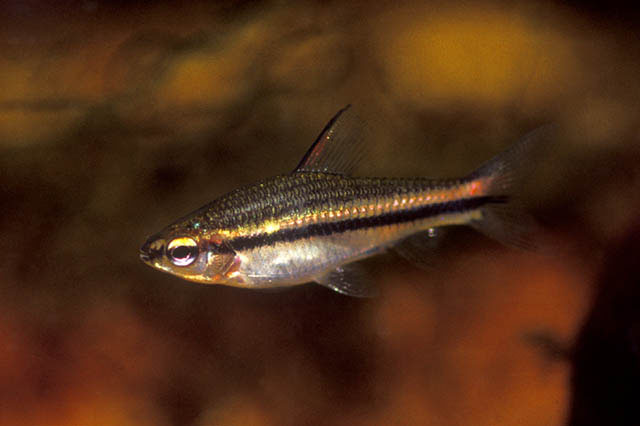| Distichodontidae (Distichodus) |
| 4.2 cm SL (male/unsexed) |
|
pelagic; freshwater; pH range: 6 - 7; dH range: 8, |
| Africa: occurs from Gambia to Chad basin except the Senegal River basin (Ref. 2936, 86396). Present in Republic of Congo (Ref. 81638), Cameroon and Gabon (Ref. 2936, 81638) and as far south as the Chiloango in Democratic Republic of the Congo (Ref. 94734). In the middle Congo basin, known from the Sangha drainage in Cameroon (Ref. 51193), Sangha and Alima and Republic of Congo (Ref. 42035) and Ubangi in Central African Republic (Ref. 2936, 94734). |
|
Dorsal spines (total): 0-0; Dorsal soft rays (total): 12-15; Anal spines: 0-0; Anal soft rays: 10-11. Diagnosis: body depth 2.8-3.8x and head length 1.8-2.2x in SL (Ref. 2936, 86396). 33-35 lateral line scales (Ref. 2936, 81638, 86396). Laterosensory canal on lateral surface of head limited to arch of pores around ventral and posterior margins of orbit and associated with preopercle; 6th infraorbital (dermosphenotic) present, with laterosensory canal segment; infraorbital present at posterior margin of orbit; maxilla with 4 or fewer teeth; maxilla falling short of vertical through anterior margin of orbit; scaly process present at base of pelvic fin; dark pigmentation along lateral surface of body two scales wide or less; dark band on lateral surface of body passing through middle of caudal peduncle; base of caudal fin unpigmented or with rounded spot that falls distinctly short of dorsal and ventral margins of caudal peduncle (Ref. 81638). 12-15 total dorsal fin rays and 10-11 total anal fin rays (Ref. 2936, 81638, 86396).
Description: snout rounded, smaller than eye (Ref. 2936, 86396). Body moderately elongate, more robust in some apparently female specimens; body depth 0.27-0.33x SL; head profile moderately acute anteriorly but with rounded snout (Ref. 81638). Caudal peduncle 1.2-1.5x longer than deep (Ref. 2936, 86936). Premaxilla and dentary with 2 rows of teeth; teeth of outer row bicuspid, teeth of inner row conical (Ref. 2936, 81386, 86396). Premaxilla with 8 teeth in outer row (Ref. 81638). Maxilla not reaching to below anterior eye margin (Ref. 2936, 86396) and with 2-3 teeth along anterodorsal margin (Ref. 2936, 81638, 86396). Laterosensory canal system of head not elaborated; body scales ctenoid and of moderate size; 10 scales between dorsal fin origin and mid-ventral line (excluding median scales); D: III-IV,9-11; A: III,7-8 (Ref. 81638). Lateral line incomplete with pores on anterior 5-7 (Ref. 81638) or 6-9 (Ref. 2936, 86396) scales.
Coloration: preserved specimens olivaceous-brown, darker dorsally on both head and body (Ref. 2936, 81638, 86396). Head with distinct mid-lateral band beginning on snout and extending to rear of opercle; band continuous posteriorly with band on body (Ref. 81638). Body with dark mid-lateral band extending from immediately posterior of opercle to posterior limit of caudal peduncle, sometimes terminating posteriorly in broader dark spot (Ref. 2936, 81638, 86396). Its width comprising lower halves of lateral-line scales and upper halves of next-lower scale row (Ref. 2936, 86396). Caudal fin with dark basal spot on middle caudal rays in region proximate to rear of mid-lateral band on body (Ref. 81638). |
| Maximum TL was recorded at 5.3 cm (Ref. 7094). |
|
Least Concern (LC); Date assessed: 11 May 2019 Ref. (130435)
|
| harmless |
Source and more info: www.fishbase.org. For personal, classroom, and other internal use only. Not for publication.

